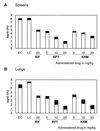Evaluation of rifapentine in long-term treatment regimens for tuberculosis in mice
- PMID: 10508006
- PMCID: PMC89482
- DOI: 10.1128/AAC.43.10.2356
Evaluation of rifapentine in long-term treatment regimens for tuberculosis in mice
Abstract
Besides direct bactericidal activity, long-term effectiveness is one of the most important features to consider when developing new drugs for chemotherapy. In this study, we evaluated the ability of rifapentine (RFP), in monotherapy and combination therapy, to completely eradicate a Mycobacterium tuberculosis infection and to prevent relapse posttreatment in a Swiss mouse model. The combination of RFP, isoniazid (INH), and pyrazinamide (PZA) administered daily resulted in an apparent clearance of M. tuberculosis organisms in the lungs and spleens of infected mice after 10 weeks of treatment. However, 3 months after the cessation of therapy, bacterial regrowth occurred in mice treated for a 12-week period, indicating a relapse of infection. In intermittent treatment regimens of RFP in combination with INH and PZA, sterilization was achieved when mice were treated two to five times per week for 9 weeks. Bacterial growth was still observed in the once-weekly treatment group. Our results show that mouse models can predict important parameters for new drugs. We stress the necessity for long-term posttreatment observation in animal models for the routine evaluation of new drugs for antituberculosis chemotherapy.
Figures

Similar articles
-
Efficient intermittent rifapentine-moxifloxacin-containing short-course regimen for treatment of tuberculosis in mice.Antimicrob Agents Chemother. 2005 Oct;49(10):4015-9. doi: 10.1128/AAC.49.10.4015-4019.2005. Antimicrob Agents Chemother. 2005. PMID: 16189074 Free PMC article.
-
Isoniazid or moxifloxacin in rifapentine-based regimens for experimental tuberculosis?Am J Respir Crit Care Med. 2008 Nov 1;178(9):989-93. doi: 10.1164/rccm.200807-1029OC. Epub 2008 Aug 21. Am J Respir Crit Care Med. 2008. PMID: 18723432 Free PMC article.
-
Treatment of tuberculosis with rifamycin-containing regimens in immune-deficient mice.Am J Respir Crit Care Med. 2011 May 1;183(9):1254-61. doi: 10.1164/rccm.201012-1949OC. Epub 2011 Feb 17. Am J Respir Crit Care Med. 2011. PMID: 21330452 Free PMC article.
-
Fighting tuberculosis by drugs targeting nonreplicating Mycobacterium tuberculosis bacilli.Int J Mycobacteriol. 2017 Jul-Sep;6(3):213-221. doi: 10.4103/ijmy.ijmy_85_17. Int J Mycobacteriol. 2017. PMID: 28776518 Review.
-
[Trends in tuberculosis treatment duration].Presse Med. 2006 Nov;35(11 Pt 2):1758-1764. doi: 10.1016/S0755-4982(06)74895-3. Presse Med. 2006. PMID: 17086138 Review. French.
Cited by
-
Gatifloxacin and ethionamide as the foundation for therapy of tuberculosis.Antimicrob Agents Chemother. 2003 Aug;47(8):2442-4. doi: 10.1128/AAC.47.8.2442-2444.2003. Antimicrob Agents Chemother. 2003. PMID: 12878502 Free PMC article.
-
Search for new drugs for treatment of tuberculosis.Antimicrob Agents Chemother. 2001 Jul;45(7):1943-6. doi: 10.1128/AAC.45.7.1943-1946.2001. Antimicrob Agents Chemother. 2001. PMID: 11408205 Free PMC article. No abstract available.
-
Efficient intermittent rifapentine-moxifloxacin-containing short-course regimen for treatment of tuberculosis in mice.Antimicrob Agents Chemother. 2005 Oct;49(10):4015-9. doi: 10.1128/AAC.49.10.4015-4019.2005. Antimicrob Agents Chemother. 2005. PMID: 16189074 Free PMC article.
-
Drug-resistant tuberculosis: emerging treatment options.Clin Pharmacol. 2011;3:51-67. doi: 10.2147/CPAA.S11597. Epub 2011 Dec 14. Clin Pharmacol. 2011. PMID: 22287857 Free PMC article.
-
Testing of experimental compounds in a relapse model of tuberculosis using granulocyte-macrophage colony-stimulating factor gene-disrupted mice.Antimicrob Agents Chemother. 2009 Jan;53(1):306-8. doi: 10.1128/AAC.01346-07. Epub 2008 Oct 13. Antimicrob Agents Chemother. 2009. PMID: 18852269 Free PMC article.
References
-
- Chapuis L, Ji B, Truffot-Pernot C, O’Brien R J, Raviglione M C, Grosset J H. Preventive therapy of tuberculosis with rifapentine in immunocompetent and nude mice. Am J Respir Crit Care Med. 1994;150:1355–1362. - PubMed
-
- Dhillon J, Dickinson J M, Guy J A, Ng T K, Mitchison D A. Activity of two long-acting rifamycins, rifapentine and FCE 22807, in experimental murine tuberculosis. Tuber Lung Dis. 1992;73:116–123. - PubMed
-
- Dhillon J, Mitchison D A. Activity in vitro of rifabutin, FCE 22807, rifapentine, and rifampin against Mycobacterium microti and M. tuberculosis and their penetration into mouse peritoneal macrophages. Am Rev Respir Dis. 1992;145:212–214. - PubMed
Publication types
MeSH terms
Substances
Grants and funding
LinkOut - more resources
Full Text Sources
Other Literature Sources
Medical

